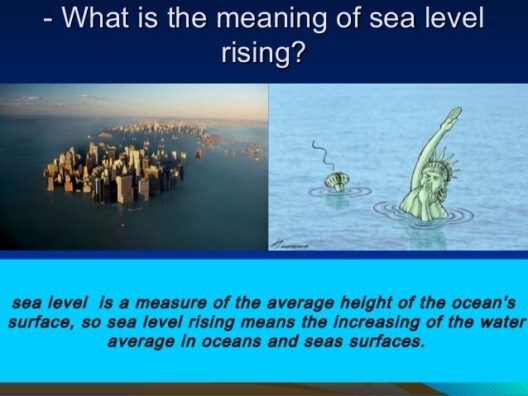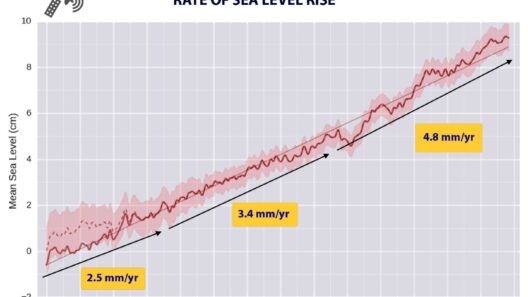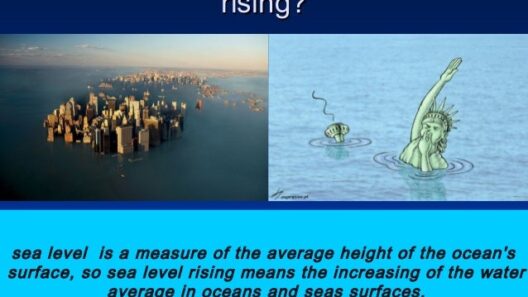Rising sea levels, an inexorable consequence of climate change, represent a formidable threat to our planet, prompting an urgent examination of how these changes reverberate through social, economic, and environmental fabrics. As the oceans encroach upon coastal populations, understanding the intricate dynamics of these impacts becomes imperative. The following sections delve into the profound implications of higher ocean levels on humanity and the ecosystem.
The Social Fabric: Displacement and Cultural Erosion
The most immediate manifestation of rising sea levels is the displacement of communities. Coastal areas, often home to vulnerable populations, face an existential threat as land is swallowed by encroaching waters. Projections suggest that by 2100, millions could be rendered climate refugees, forced to abandon their homes and ancestral lands. Such displacement not only engenders physical relocation but also leads to the dissolution of cultural identities deeply rooted in these regions.
Furthermore, as communities uproot themselves, a cascade of social challenges emerges. The strain on urban centers tasked with accommodating these migrants can provoke tensions over resources, housing, and employment. These pressures can exacerbate existing inequalities and ignite social unrest. The sense of belonging, once firmly anchored in the soil of one’s homeland, risks being lost. Vulnerable groups, including indigenous populations, are particularly at risk as their longstanding traditions and histories are threatened by the relentless rise of the sea.
As coastal cultures dissipate, the implications extend beyond borders. The loss of traditional knowledge regarding marine ecosystems—honed over generations—could hinder global understandings of sustainable practices. In this way, rising sea levels not only reshape landscapes but also dilute the cultural tapestry that enriches human civilization.
Economic Ramifications: A Tidal Wave of Costs
The economic ramifications of rising sea levels are as significant as they are multifaceted. Coastal cities, which house substantial segments of the world’s population and economic activity, are uniquely vulnerable. Billions of dollars in property and infrastructure are at stake. The reality of frequent flooding and increased storm intensity due to climate change translates into mounting repair costs and insurance claims, further straining governmental budgets and taxpayer resources.
Real estate markets face immense volatility as property values in at-risk areas plummet. Homeowners find themselves in precarious situations, often trapped in properties that diminish in value and desirability. This situation can lead to widespread financial instability, underscoring the intricate connection between environmental health and economic security.
The fisheries industry also faces turbulent waters. Oceanic changes caused by rising sea levels can affect habitat ranges for marine species, diminishing fish stocks crucial to local economies. As a result, fishermen find their livelihoods threatened, prompting not just economic decline but also food insecurity in communities that depend on these resources for sustenance.
The global economy, inherently interconnected, also reflects the repercussions of rising seas. Supply chains disrupt as ports inundate and transportation networks become vulnerable. Businesses may face interruptions in operations, causing ripple effects throughout the economy. As a result, investing in climate resilience infrastructures—though costly—becomes an imperative to safeguard economic stability.
Environmental Consequences: An Ecological Balancing Act
The environmental impacts of rising sea levels are perhaps the most extensive, affecting ecosystems globally. Coastal wetlands, often dubbed nature’s buffers, act as critical filters for pollutants and provide habitat for diverse species. As tides rise, these ecosystems are threatened by saltwater intrusion, leading to a decline in biodiversity. This loss not only imperils the species that rely on these habitats but also compromises the services they provide, including carbon sequestration.
Coral reefs—vibrant ecosystems teeming with life—are also adversely affected by rising sea levels. Increased water levels can alter light penetration, affecting the delicate balance that sustains coral health. Moreover, elevated sea temperatures, a byproduct of climate change, lead to coral bleaching, further exacerbating the plight of marine ecosystems. The interdependency of these species means that the loss of one can lead to cascading effects throughout the food web.
Shoreline erosion is another pressing environmental consequence of rising sea levels. As beaches recede, not only are natural habitats lost but the ability of coastlines to absorb storm surges diminishes, amplifying the vulnerability of inland areas to natural disasters. The paradox of relying on ecosystems to mitigate the effects of a changing climate becomes evident; the very tools we depend on for protection are eroding beneath our feet.
A Call to Action: Embracing Resilience and Adaptation
As we acknowledge the staggering socio-economic and environmental impacts of rising sea levels, the urgency of proactive measures becomes clear. Investing in resilient infrastructure, restoring natural habitats, and enacting policies that prioritize sustainability are essential steps. Collaboration across governments, businesses, and communities is crucial to forge pathways towards adaptation and mitigation. Raising awareness and encouraging actionable change can empower individuals to contribute to local and global solutions.
In conclusion, the consequences of rising sea levels extend far beyond physical alterations to our landscapes. They penetrate the very core of human existence, challenging our social structures, economic systems, and ecological balance. The time for action is now; the fate of our communities and ecosystems hangs in the balance as we grapple with the realities of this pressing challenge. A concerted effort toward resilience and responsible stewardship can illuminate a path forward—one that honors both humanity and the intricate web of life to which we belong.








